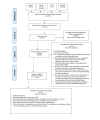Barriers and Facilitators That Influence Telemedicine-Based, Real-Time, Online Consultation at Patients' Homes: Systematic Literature Review
- PMID: 32130131
- PMCID: PMC7059083
- DOI: 10.2196/16407
Barriers and Facilitators That Influence Telemedicine-Based, Real-Time, Online Consultation at Patients' Homes: Systematic Literature Review
Abstract
Background: Health care providers are adopting information and communication technologies (ICTs) to enhance their services. Telemedicine is one of the services that rely heavily on ICTs to enable remote patients to communicate with health care professionals; in this case, the patient communicates with the health care professional for a follow-up or for a consultation about his or her health condition. This communication process is referred to as an e-consultation. In this paper, telemedicine services refer to health care services that use ICTs, which enable patients to share, transfer, and communicate data or information in real time (ie, synchronous) from their home with a care provider-normally a physician-at a clinical site. However, the use of e-consultation services can be positively or negatively influenced by external or internal factors. External factors refer to the environment surrounding the system as well as the system itself, while internal factors refer to user behavior and motivation.
Objective: This review aims to investigate the barriers and the facilitators that influence the use of home consultation systems in the health care context. This review also aims to identify the effectiveness of Home Online Health Consultation (HOHC) systems in improving patients' health as well as their satisfaction with the systems.
Methods: We conducted a systematic literature review to search for articles-empirical studies-about online health consultation in four digital libraries: Scopus, Association for Computing Machinery, PubMed, and Web of Science. The database search yielded 2518 articles; after applying the inclusion and exclusion criteria, the number of included articles for the final review was 45. A qualitative content analysis was performed to identify barriers and facilitators to HOHC systems, their effectiveness, and patients' satisfaction with them.
Results: The systematic literature review identified several external and internal facilitators and barriers to HOHC systems that were used in the creation of a HOHC framework. The framework consists of four requirements; the framework also consists of 17 facilitators and eight barriers, which were further categorized as internal and external influencers on HOHC.
Conclusions: Patients from different age groups and with different health conditions benefited from remote health services. HOHC via video conferencing was effective in delivering online treatment and was well-accepted by patients, as it simulated in-person, face-to-face consultation. Acceptance by patients increased as a result of online consultation facilitators that promoted effective and convenient remote treatment. However, some patients preferred face-to-face consultation and showed resistance to online consultation. Resistance to online consultation was influenced by some of the identified barriers. Overall, the framework identified the facilitators and barriers that positively and negatively influenced the uptake of HOHC systems, respectively.
Keywords: barriers; eHealth; electronic consultation; facilitators; mHealth; mobile health; online consultation; video conferencing.
©Hassan Khader Y Almathami, Khin Than Win, Elena Vlahu-Gjorgievska. Originally published in the Journal of Medical Internet Research (http://www.jmir.org), 20.02.2020.
Conflict of interest statement
Conflicts of Interest: None declared.
Figures


References
-
- Roine R, Ohinmaa A, Hailey D. Assessing telemedicine: A systematic review of the literature. CMAJ. 2001 Oct 18;165(6):765–771. http://www.cmaj.ca/cgi/pmidlookup?view=long&pmid=11584564 - PMC - PubMed
-
- Telemedicine: Opportunities and Developments in Member States. Report on the Second Global Survey on eHealth. Geneva, Switzerland: World Health Organization; 2009. [2019-12-31]. https://www.who.int/goe/publications/goe_telemedicine_2010.pdf.
-
- Serrano C, Karahanna E. The compensatory interaction between user capabilities and technology capabilities in influencing task performance: An empirical assessment in telemedicine consultations. MIS Q. 2016 Mar 3;40(3):597–621. doi: 10.25300/misq/2016/40.3.04. - DOI
-
- Vimalananda VG, Gupte G, Seraj SM, Orlander J, Berlowitz D, Fincke BG, Simon SR. Electronic consultations (e-consults) to improve access to specialty care: A systematic review and narrative synthesis. J Telemed Telecare. 2015 Oct;21(6):323–330. doi: 10.1177/1357633X15582108. http://europepmc.org/abstract/MED/25995331 - DOI - PMC - PubMed
Publication types
MeSH terms
LinkOut - more resources
Full Text Sources
Medical

